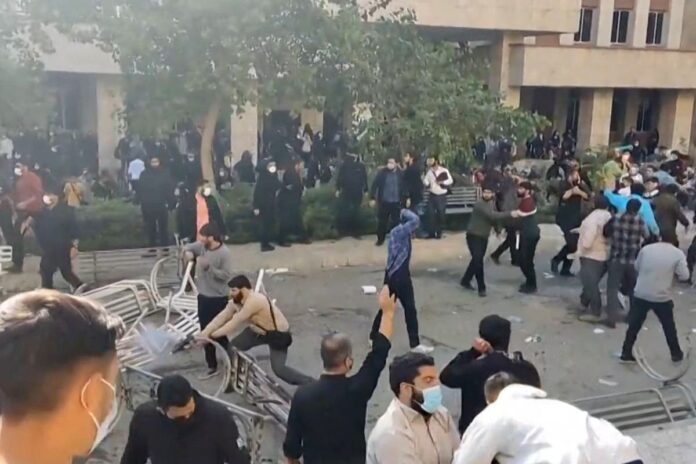Iran’s security forces have launched fresh attacks on universities and threatened protesters with the death penalty or long prison sentences in what appears to be a stepped up effort by the Revolutionary Guard to crush the nationwide protest movement that has posed one of the most serious threats ever to the Tehran’s regime’s grip on power.Video footage showed plainclothes officers and pro-regime Basij paramilitary under the authority of the Revolutionary Guard attacking protests on campuses throughout the country, mostly firing teargas or clubs.In a 30 October incident university guards in Sanandaj stood in front of students to prevent armed men on motorcycles from firing on protesters. In another incident on Sunday, a regime operative pulled out and fired a handgun during a protest at a campus in Tehran, prompting panic.’The guy has a gun! He’s got a Colt!’ a man calls out in a video posted online.Video posted to social media shows protesters avoiding projectiles during clashes at Iran’s University of North TehranIran’s judiciary on Monday said it would put 1,000 protesters detained in Tehran on trial in the ideologically charged Revolutionary Courts in the coming days.At least 284 Iranians have been killed and 14,056 arrested in 45 days of protests that have reached 133 cities and towns. The regime for days has been signalling a widening of a crackdown on the protests, which were triggered by the 16 September death of a 22-year-old woman arrested by the morality police for violating hijab rules.In a rare joint report released on 28 October, the Revolutionary Guard and Ministry of Intelligence and Security described the daily protests against the regime as a widespread conspiracy manufactured by Tehran’s enemies in the United States. United Kingdom, Israel and Saudi Arabia.’The CIA, in cooperation with allied intelligence services and reactionary proxies, before the start of the riots, launched a nationwide conspiracy in Iran with the aim of committing crimes against the great nation of Iran and its territorial integrity,’ said the 27,000-word report.The report was filled with unverifiable claims about clandestine meetings between Iran’s enemies in the months preceding the unrest. The document singles out Niloufar Hammedi and Elaheh Mohammadi, two local journalists who were among the first to break the story of Amini’s 13 September arrest, subsequent death and politically charged funeral. They are accused, without evidence, of being western-trained spies. The two women were abducted by regime forces in the first days of the unrest and are believed to be held in solitary confinement inside Tehran’s notorious Evin Prison, Many worry for their well-being. Espionage is punishable by death in Iran. Hundreds of Iranian journalists have signed an open letter in their defence.Iranian journalists Niloufar Hammedi (left) and Elaheh Mohammadi were among the first to report on the death of Mahsa Amini. Both are jailed and being accused of espionageOn Saturday, Maj Gen Hossein Salami, commander of the Revolutionary Guard, declared protests over and warned of a harsh response should they continue.”Today is the end of the riots,’ he said. ‘Do not take to the streets anymore. What do you want from this nation?”A court also began trying six protesters arrested in the weeks, charging them with the grave offence of ‘waging war against God,’ a crime under Islamic Sharia law that carries a possible death sentence in Iran.Pro-regime news outlets have begun depicting the entire protest movement as an attempt at ‘pinkwashing’ the so-called ‘regime change’ policies of the West.Analysts say the regime is trying to frighten Iranians off the streets with harsh statements, the threats of tough prison sentences and deadly violence, as it has during previous upsurges of popular protest since 1999. Experts predict more arrests, show trials, and forced confessions to wild conspiracies in an effort to terrorise the public.’We’ve seen it all before. This is a playback,’ said Afshon Ostovar, a professor of National Security Affairs at the Naval Postgraduate School and author of a book about the Revolutionary Guard. ‘They’re falling back into established habits.’Iran’s Revolutionary Guard is a parallel branch of the armed forces with a mandate to protect the 1979 Islamic revolution at any cost. It has grown into a powerful and ideological behemoth with deep tentacles in domestic affairs, commerce and foreign policy. It has overwhelmed other institutions, including the regular security forces, the intelligence services and the parliament, which is filled with former Guard members.But the Guard is now under enormous pressure. It is grappling with a widespread protest movement with the stated aim of toppling the rule of Iran’s supreme leader, Ali Khamenei.Led by women and youth outraged at Amini’s death and opposed to the country’s mandatory hijab rules and political repression, the movement has failed to succumb to political pressure. On Monday, hundreds of students at campuses across the country defied the regime’s threats and took part in protests.Several European countries and Canada are also discussing whether to join the US in listing the Revolutionary Guard as a terrorist organisation in part over its role in the violence against mostly unarmed protesters. “The Guard is an official military organisation of the Islamic Republic and such an action would be completely illegal,” Iranian foreign ministry spokesman Nasser Kanani told reporters on Monday.Regime gunmen massacred hundreds of Iranians in less than a week during November 2019 protests over rising prices. But outside of long rebellious border areas populated by ethnic minorities, the security forces have exercised a measure of restraint in the latest round of violence because of the prominent role played by women.’What’s preventing the Revolutionary Guard from resorting to all-out violence is that the world perceives this is a movement led by women who want a right that almost all women in the world have,’ said Mr Ostovar. ‘They know that killing women and young women is ugly and it’s difficult to excuse and legitimise to both the outside world and their own ranks.’
Iran’s Revolutionary Guard steps up efforts to crush hijab protests
Sourceindependent.co.uk
RELATED ARTICLES


